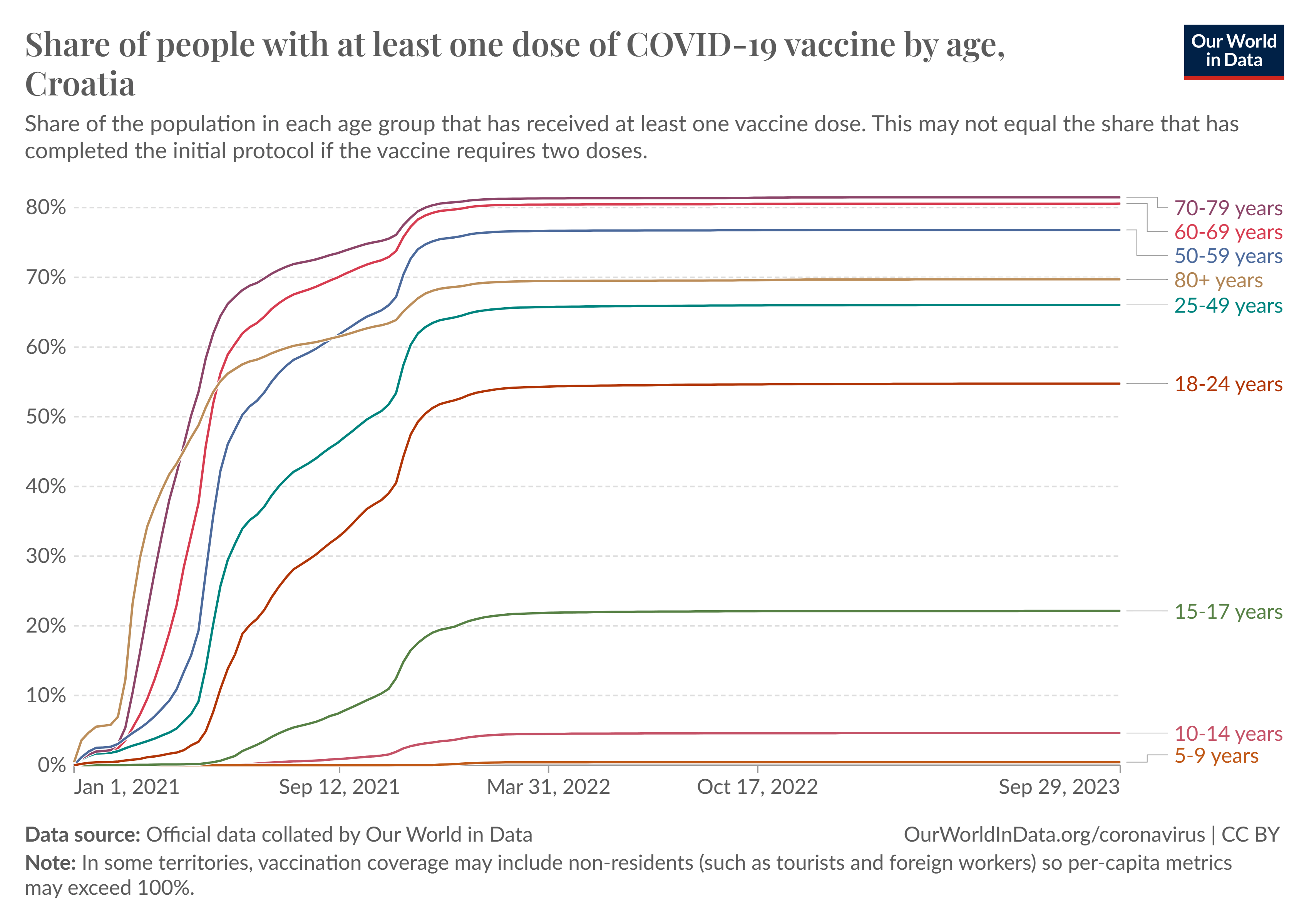
Inadequate support: No available evidence to date supports the claim that there is an increase in cases of rapidly-progressing cancers (“turbo cancer”) following COVID-19 vaccination, contradicting Pavic’s analysis.

FULL CLAIM: “Pathologist reports a stunning 52% increase in cancer risk for ages 15-59 who were vaxxed”; “while 55% of the 15 to 59 year olds are vaccinated, 65% of the carcinoma cases in that age group had one or more shots”
REVIEW
Since the rollout of COVID-19 vaccines in late 2020, false claims have spread that these vaccines cause cancer. However, fact-checks by Science Feedback and other fact-checking groups showed that these claims weren’t backed up by any scientific evidence and were often rooted in flawed analyses.
The U.S. National Cancer Institute states that “there is no evidence that COVID-19 vaccines cause cancer, lead to recurrence, or lead to disease progression”. Furthermore, the Institute recommended that people with cancer get vaccinated against COVID-19, as they are at a greater risk of severe disease.
Likewise, the European Society for Medical Oncology also recommends COVID-19 vaccination for cancer patients and finds that “COVID-19 vaccines are safe and very well tolerated by patients with cancer”.
In spite of this, entrepreneur Steve Kirsch continues to push the narrative that COVID-19 vaccines increase the risk of developing cancer. In a March 2024 Substack article, Kirsch claimed that a pathologist reported “a stunning 52% increase in cancer risk for ages 15-59 who were vaxxed”. Kirsch also repeated this claim on his X (formerly Twitter) account. Kirsch has repeatedly disseminated incorrect information about COVID-19 vaccines in the past.
Kirsch’s Substack article essentially repeated the conclusions of an analysis carried out by Croatian pathologist Ivana Pavic, who published her results on her own Substack page. However, Pavic’s and Kirsch’s reasoning is flawed, as we explain below.
What did Pavic do and what did she find?
Pavic first looked at the proportion of vaccinated and unvaccinated individuals among patients under 55 years of age who were diagnosed with cancer in 2022 in two Croatian hospitals. To avoid including cases of cancer relapse, she excluded those who already had cancer before 2020. She also excluded those with skin cancer, melanoma, lymphoma, and leukemia, although she didn’t provide a reason why she decided to exclude these people.
Pavic found that 65% of patients diagnosed with cancer in 2022 had been vaccinated against COVID-19. She then compared that proportion with the proportion of vaccinated people in the general population for people aged between 18 and 59 years (61.32%) and people aged between 15 and 59 years (55.34%).
Pavic reasoned that if COVID-19 vaccination had no effect on the risk of developing cancer, the proportion of cancer patients who were vaccinated should be the same as the proportion of vaccinated people in the general population.
Observing that vaccinated individuals were overrepresented in the cancer group relative to the general population (65% versus 61.32% or 55.34%), Pavic suggested that mRNA COVID-19 vaccines could be responsible. Kirsch then reacted to Pavic’s data by concluding that it showed “a stunning 52% increase in cancer risk for ages 15-59 who were vaxxed”.
Pavic’s analysis doesn’t account for confounding factors and cancer latency
Kirsch’s bold claim belies significant limitations in Pavic’s analysis. First, it relies on directly comparing the proportion of vaccinated individuals in the population with cancer to that of the general population. But the analysis failed to consider that both the likelihood of getting vaccinated and of being diagnosed with cancer can be jointly affected by the same factors. These are known as confounding factors.
For example, it’s expected that the group with cancer is older than the general population, because the risk of cancer increases with age.
And we also know that older people tend to be more likely to get vaccinated than younger people. So, there’s a high chance that the COVID-19 vaccine coverage in the cancer group is higher simply because the population is older.
In short, the finding that vaccinated people are disproportionately greater in the group with cancer compared to the general population may simply have to do with the fact that both cancer and COVID-19 vaccination status are associated with advanced age. One way to reduce the effect of age as a confounding factor is to ensure that both the cancer group and the general population are similar in terms of age distribution, but this wasn’t done by Pavic.
Another possible confounding factor is the difference in health-seeking behavior between the cancer patient population and the general population. Indeed, it’s plausible that vaccinated people are more likely to seek out medical care compared to unvaccinated people, which lead them not only to get vaccinated but also to get screened for cancer more often.
Getting screened more often would increase the likelihood of detecting developing cancers. As a result, it would lead to an overrepresentation of vaccinated people among those who were recently diagnosed with cancer. This is yet another possibility that Pavic’s analysis didn’t consider.
Second, the analysis focused on the cancer patients who were diagnosed in 2022, two years after the beginning of the COVID-19 vaccination campaign. However, cancer is a disease that takes a long time to develop.
Cancer Research UK explains that “[i]t can take many years for a damaged cell to divide and grow and form a tumor big enough to cause symptoms or show up on a scan”. Thus, the cancer cases included in Pavic’s analysis may very well have begun well before the start of the COVID-19 vaccination campaign.
Pavic suggests that cancers tied to COVID-19 vaccination develop with a “galloping behavior”—in other words, that it’s possible these cancers are already showing up in screenings because they’ve developed so rapidly. However, the claim that COVID-19 vaccines are associated with this so-called “turbo cancer” is unsubstantiated, as we and others reported.
Pavic’s analysis contains flaws in calculations of vaccine coverage that affect the analysis’ reliability
As we explained earlier, Pavic’s reasoning hinges on comparing the vaccine coverage in the population diagnosed with cancer and in the general Croatian population. Therefore, it is important to ensure that the calculation of the proportion of vaccinated people in the general population is accurate.
However, Pavic’s calculation of the percentage of vaccinated individuals in the groups 18 to 59 and 15 to 59 of the general population is debatable. Her Substack article explained that she calculated the median of the vaccine coverage of four age groups: 15-17, 18-24, 25-49, and 50-59.
A median of 55.34%, as reported in her article, means that half of these age groups have a vaccine coverage higher than 55.34% and half have a coverage lower than 55.34%.
However, this approach has two issues. First, using the median can conceal the large variability of vaccine coverage across age groups.
In fact, only 21.63% of people aged 15 to 17 in Croatia are vaccinated, whereas this proportion reaches 73.74% in those aged 50 to 59 (Figure 1). Thus, in this case, the median is a value that is mathematically correct but doesn’t accurately represent the vaccine coverage of the groups.

Figure 1 – Share of vaccinated individuals in the Croatian general population, stratified by age. Source: Our World in Data.
Second, directly calculating the median from the vaccine coverage of each age group implies that the age groups are all of roughly equal size.
However, this isn’t the case for Croatia. The age pyramid for Croatia shows that there are more people aged 50 to 59 than people aged 20 to 29. Thus, the median that Pavic calculated also doesn’t accurately reflect the age distribution of the Croatian population.
In short, the validity of the baseline vaccine coverage that Pavic calculated—which underpins the claim that vaccinated people are disproportionately more likely to develop cancer—is in doubt. Reliably comparing vaccine coverage between groups would require accounting for several factors, like age group and the age structure of the general population.
Health Feedback reached out to Pavic for comment and will update the review if new information becomes available.
Conclusion
Pavic’s analysis contains several flaws that invalidate its conclusions. It didn’t take into consideration the possible effect of confounding factors, such as age and health-seeking behaviors, that could influence both the likelihood of getting vaccinated and the likelihood of a cancer diagnosis. It also used an improperly calculated vaccine coverage of the general population as a baseline to assess whether vaccinated individuals are overrepresented among cancer patients.
Furthermore, Pavic’s analysis and Kirsch’s conclusions are at odds with observations from medical experts, who haven’t observed an increase in cancer following COVID-19 vaccination to date . Observations available to date show that COVID-19 vaccines are safe with benefits in terms of protection against severe diseases outweighing their risks.


